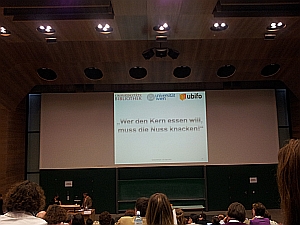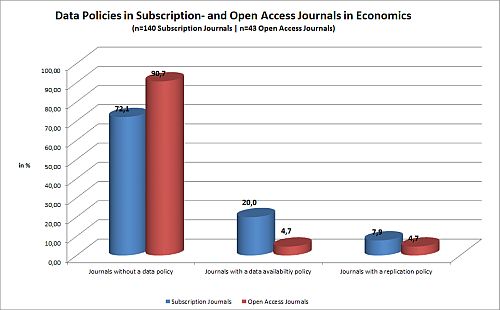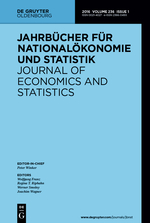Data Policies in Open Access Journals: Not all that glitters is “gold”
Posted: October 15th, 2012 | Author: Sven | Filed under: Conference, EDaWaX | Tags: Data Policies, Data Sharing, open access | 1 Comment » At the end of September, I was in beautifull Vienna for some days and presented a few results of our project at the 6th Open Access Days in a session about “Making Research Data publicly available: opportunities and challenges“.
At the end of September, I was in beautifull Vienna for some days and presented a few results of our project at the 6th Open Access Days in a session about “Making Research Data publicly available: opportunities and challenges“.
It’s been a very nice conference – and some blogposts [Uli Herb -> telepolis (in German) | Astrid Recker -> admtic (in English)] report on the conference and some of the presentations. My colleques Olaf Siegert, Ralf Flohr and I also wrote a summary of the conference for ZfBB (in German) that will be published in the next issue of the journal.
Well, to come back to my talk: In this post I want to point out some single aspects of my presentation: the availability of data policies in economic scholarly journals that are published open access.
Our project compared the number and quality of data policies we found in a sample of 43 open access Journals to a sample of 141 traditional subscription journals in regard to the implementation of data availability policies.
Generally speaking I wondered how open access journals acquit themselves in this context. Prior to starting our analysis I was quite sure that the percentage of journals equipped with a data availability policy would be higher in open access journals than the proportion of subscription journals equipped with such a policy. I even thought that open access journals could have a comparative advantage to traditional subscription journals:
Some of these potential advantages are listed below:
- Normally the publisher maintains the website of a subscription journal. Generally I think that publishers are not really interested in additional work like maintaining a data archive, as long as they don’t earn money with these additional services. But this is only one site of the coin. Also in the publisher’s sector (Brussels Declaration) or with the announcement of a data citation index by Thompson Reuters it is quite obvious that publishers and companies are on the move and that they are discussing about research data in journals and even potenial business models. Some journals as Earth System Science Data even publish peer-revied research data. But nevertheless, for the vast majority of traditional journals I’m quite sure that publishers consider the management of a data archive as additional work only, what might be seen as a chance for open access journals.
- The editors of open access journals know almost very well how to establish a data archive. From a technical point of view it shouldn’t be too hard to implement one of the software solutions available (e.g. Nesstar, Dataverse, CKAN/thedatahub). A very good exmaple of an economic scholarly open access journals is the Economics E-Journal that implemented a data archive based on Dataverse.
- When I take into account, that OA-journals disseminate the articles quicker than traditional subscription journals and that articles in open access journals are cited more often than articles in traditional journals (and citations are very important for economists) I would assume that OA-journals should be on the forefront of of the scientfic debate. When we implicate that articles with accompagning datasets are cited even more often someone might assume that Open Access Journals will use these advantages to establish themselves in the scientific publishing market. Because of these two advantages OA-journals therefore should be important journals in the market for reproductible research. They can estabish their place in the market with quality assured and peer-reviewed articles that are equipped with data and code.
Based on these assumptions we analysed 43 economic Journals that are listed in the DOAJ (rubric: Economics). We used a sample of OA-journals that primarily publish articles in English. As we did it with the 141 journals in our sample for work package 2, we checked the journal website(s) for data (availability) policies: If we found a data policy we used some criteria to gauge the quality of these data policies.
Well, the sad result is that only two (!) open access journals in our sample are equipped with a data policy (4,65%). In sharp contrast to these findings we were able to find 28 journals in a sample of 140 subscription journals (20%).
Because of the marginal percentage of OA-journals equipped with a data policy, we did not analyse the data policies in depth. One of the two OA-journals has already been analysed in wok package 2. In my opinion this journal (Economics, the Open Access, Open Assessment E-Journal) is a very good example of how OA journals might use their respective advantages to position in the market. The E-Journal did it. It is ranked in the Journal Citation Report and has established in the market. Besides, it is equipped with a a very useful data availability policy, based on the data availability policy of the American Economic Review (AER).
So in my opinion the publishers of the OA-journals have missed their chance to establish in the market for reproducible research up to now. Maybe the editors of open acces journals should think about these results and try to estabilsh themselves in the market for reproductible research.
At least in my opinion they will benefit from doing so.









This is what I have been searching in quite a few web pages and I ultimately identified it right here. Wonderful post. I am so impressed. Could under no circumstances imagine of these a point is attainable with it…I imagine you have a excellent information in particular while dealings with these kinds of topics.